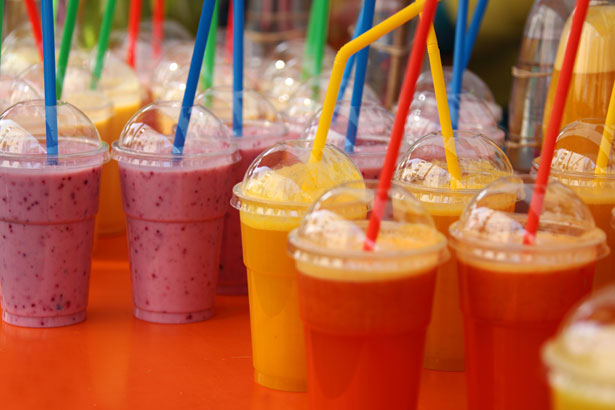Juicing Nutrition
Health & Beauty From the Inside
Juicing nutrition benefits include silky hair, glowing skin and can even contribute to weight loss. Juicing is one of the healthiest and most natural ways to consume all the nutrition your body craves and vegetable juice is often the base for many holistic nutrition practices for new vegans and raw foodists.

Whether you are doing a body cleanse or helping your body heal, you will gain more benefit from 12 ounces of juice than any mulitivitamin pill.
Fresh made vegetable and fruit juice is the best way to drink it - as opposed to a pre-made bottle or can. By drinking it within an hour of being made, you will receive the benefit of not only the vitamins, minerals and other phytonutrients that feed your body, but you will take advantage of the live enzymes your body uses to make fresh, healthy new cells. And since we have billions of cells that turn over every day – this means you are creating a fresh, healthy body each time you drink fresh made juice!
How Does Juicing Nutrition Work?
Juicing is a method of extracting the juice, or pure vitamin and mineral water, from the fiber and bulk of vegetables and fruits. By doing so, the nutrients are more easily absorbed into your body, and more available for your body to utilize where needed. If your digestion is not up to par, you will benefit as your body does not have to break down and digest the fibers in order to extract the nutrients from the juice. This allows your body more nutrition, more energy and more healing powers from the fruits and vegetables that you juice.
To
avoid the insulin spike of fruit juice, direct your focus to
vegetable juicing. This will also help close the nutrition gap that
three quarters of Americans are missing out on by not eating enough
daily vegetables. If you are new to juicing or dealing with a health
issue, start with a smaller amount of juice at one time; 10-12 ounces
or so will do.
Fresh
vegetable juice has different qualities and benefits than smoothies
do. First of all, smoothies are more often a meal replacement or
full snack, keeping the fiber in tact. This make the smoothie much
thicker than juice, therefore may require different ingredients to
make it palatable. Often, other supplements are added to a smoothie
such as protein powder, dates, or even healthy fibers such as flax or
hemp seeds. These are very nutritious drinks, and can greatly
enhance any daily health regimen.
Juice, on the other hand, contains no fiber, making the nutrients more easily absorbed and utilized by the body. It contains live enzymes that are the foundation of life and used by our bodies to break down fats and proteins, provide cell energy, and repairing tissues in the organs, brain and all other parts of our bodies. These enzymes are often destroyed through cooking, food processing or packaging, which may explain why juicing helps the body heal so quickly while providing abundant energy for those who drink it daily.
Types of Juicers
Machines for juicing come in a variety of types; masticating, centrifugal and press. Each makes juice differently and each has its own pros and cons. If budget is an issue, than it is better to just purchase what you can afford, because some juice is better than no juice.
Centrifugal
juicers are commonly found in large department or variety stores.
They are the most affordable with some as low as $40. The work by
pushing produce into a rapidly spinning chamber. Here, the produce
is shredded into pulp then pushed through a filter while the juice is
sent out a spigot. The pros of this machine are the low cost, it is
lightweight and most take a small space on the counter. The down
side of these juicers is that you do not get the same amount of juice
than you would by using a masticating juicer and they are not
effective to juice leafy greens. In addition, it is said the juice
from these spoil quicker, so should be drank right away.
Masticating juicers are heavier and found more in specialty stores or online. To make juice, cut vegetables and fruits are pushed into a tube (as opposed to a chamber as in the centrifugal juicer), where they are then crushed and squeezed by a rotating metal-tooth lined cylinder within a tube. Juice is drained out the bottom while the pulp is sent to the end of the cylinder. The action is slower and does not heat the juice as much as a centrifugal, allowing more enzymes to stay in tact. The more popular brands are Champion, Omega and Green Star. I owned both, a masticating and centrifugal juicers, but I was able to extract about 50% more juice from the same amount of vegetabes from my Champion Juicer. Another pro – I have owned it for over 20 years and it still works well. I did have to have the engine rebuilt at one point, but it was still less than half the cost of a new juicer of the same type. The down side is it is very heavy, so I either leave it on the counter or store it just below.
The hydraulic press is the most expensive of juicers. They are said to produce 50-100% more juice and nutrients than any other juicers. A juice press does just that – it will press the produce to a pulp which is then pressed again by a hydraulic press. Some call this cold pressing because it does not heat up in any way and there is no oxidation so as to preserve even more nutrients. Norman Walker invented the first model, called the Norwalk Juicer, which runs around $2,500, but there are others now on the market such as the Welles Juice Press which is more affordable. While you may not press the same amount of juice as the high-end Norwalk, you will receive the amazing benefits of more live vitamins, minerals and enzymes is said to be the same. In either case, these juicers require two steps; first you press the produce into pulp, then process the pulp into juice. For some this may be cumbersome, however the result is a tasty juice with no foam or oxidation.
No matter which kind of juice you purchase, be kind to your juicer – don't just throw in your produce with skin, seeds and core if it is not made for it. When I had a centrifugal juicer, I only put basic vegetables in it, minus the leafy greens. I peel beets and ginger because they are tough and I baby my juicer to last longer. Also, I have had juice that my friends' made with the skins of certain produce (pineapple, beets) and it tastes very bitter to me, so I avoid it. I do not peel carrots as the skin is not really thick.
Best Practice for Juicing Nutrition
Use organic produce to make your juice to get more flavor and more nutrition. Organic produce is normally grown in soil that is more fertile, meaning it contains more nutrients, which are passed on into the vegetables and fruits growing from it. No conventional fertilizers are used in organic farming, which allows the produce to grow slower,, allowing more nutrient development. While some modern research is claiming that organic is no more nutritious, other do show not only do they contain more vitamins, minerals and other phytonutrients, but they have a significantly higher amount of antioxidants.
Personally, I believe taste says it all. Organic produce from a large chain may lack flavor, while a chain that obtains its produce from a true local, organic farm will be packed with flavor. Shopping at a local Farmer's Market will give you a chance to support local farmers and even ask the growers or farmers questions about the produce. Either way, let your taste buds guide you; your juice will taste better.
Start juicing with the basics; carrots for your skin, celery for body cleansing and detoxification, beets for blood building and kale, spinach, dandelion greens or some other dark, leafy vegetable that you might miss out on eating during the week. Switch it up so you don't get bored, do get a variety of nutrients and avoid allergies (by drinking too much of the same, repeatedly).
Drink your juice before your meals or in between meals to ensure your body is more able to absorb all the nutrients. Think about your health issues and what you would like to gain from juicing, then find the vegetables to go with. Juice lemons on the side and add it to your juice for a fresh flavor, and don't forget spices like ginger or garlic for added healing power and flavor.
If you decide to make and store your juice before you drink it, keep these rules in mind. Centrifugal juice should be drank right away because it will spoil, so do not store it. Juice made with a masticating juicer can be stored in opaque containers for 1-3 days, but you will lose enzyme action and some nutrients. A juice press will store your juice the longest, 3-5 days in an opaque jar, and will keep many nutrients and enzymes in tact.
Juicing for Beauty
Fresh vegetable juice can add nutrition that is often lost while dieting or with the every day American diet. When we consume all the nutrients and enzymes we need, our bodies can create beautiful, fresh skin cells to replace the old. Muscle tissue can repair easier and more energy will be available so we can exercise.
Many dieters benefit with juicing or smoothies as meal replacements or healthy snacks. Adding protein can give the boost you need to stay strong and lose fat. You can also ensure you consume enough veggies by juicing them, and even add leafy greens if that is what you lack.
No matter how you juice, remember that health creates beauty from the inside out. At the same time, your mind stays healthy and energy levels high, so you can live life to the fullest.




